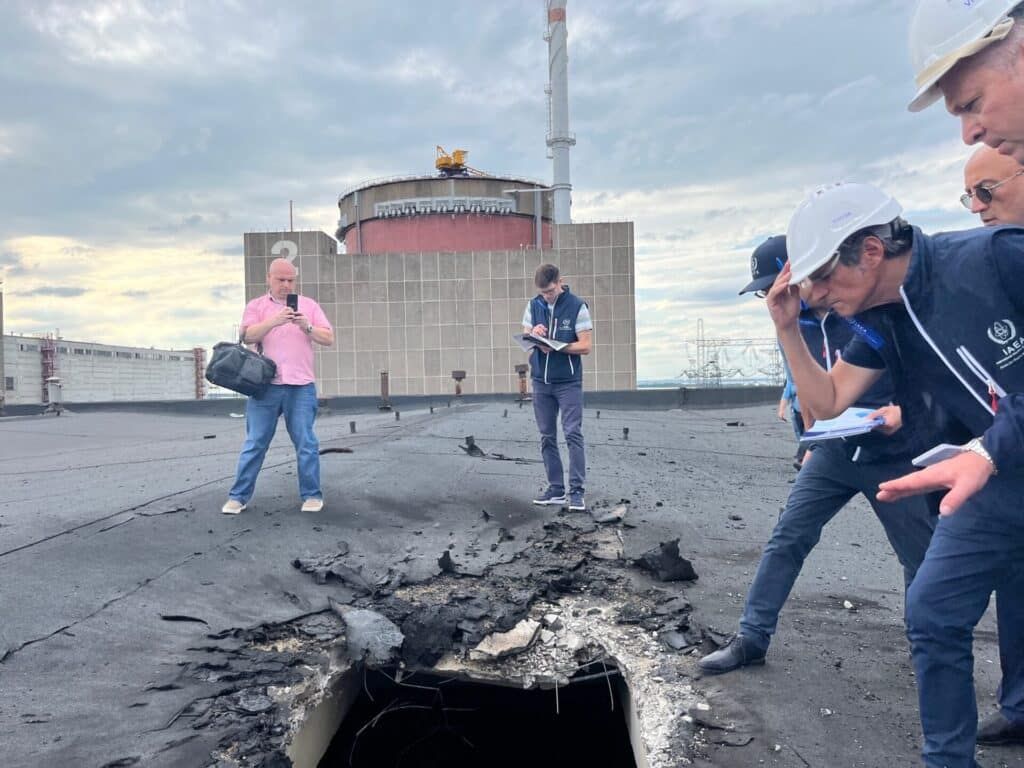Lessons from Zaporizhzhia: How to protect reactors against ‘nuclear piracy’
By Ali Alkis, Bethany Goldblum | September 20, 2023
 IAEA Director General Rafael Mariano Grossi and members of the International Atomic Energy Agency (IAEA) delegation inspect the impacts of a rocket shell during a visit to the Zaporizhzhia nuclear power plant in Ukraine on September 1, 2022. (Photo Fredrik Dahl / IAEA)
IAEA Director General Rafael Mariano Grossi and members of the International Atomic Energy Agency (IAEA) delegation inspect the impacts of a rocket shell during a visit to the Zaporizhzhia nuclear power plant in Ukraine on September 1, 2022. (Photo Fredrik Dahl / IAEA)
More than a year has passed since the world was shaken by the Russian occupation of the Zaporizhzhia nuclear power plant in Ukraine. But despite the passage of time, a chilling reality remains: Russia maintains control over the plant, a situation that serves as a constant reminder of the dire threats plaguing modern nuclear security. In this new environment, effective nuclear security demands a re-evaluation of priorities, because the occupation exposed a wholly new kind of risk: Russia—a nuclear weapon state—continues to attack, shell, mine, occupy, and operate a Ukrainian nuclear facility as a part of its so-called “special military operation” against Ukraine.
Nuclear security has traditionally focused on physical protection from a variety of threat vectors; the protective measures are colloquially referred to as “guns, guards, and gates.” This dates back to defenses against state-sponsored espionage during the Manhattan Project era and began to include concerns over “loose nukes” after the fall of the Soviet Union. In the wake of the 9/11 terrorist attacks on the United States, the nuclear security community has focused somewhat myopically on the non-state actor threat—despite those attacks not being nuclear or radiological in nature.
But what are today’s threats? One stands out: Deliberate hostile action by state actors against facilities housing nuclear material—such as nuclear reactors—resulting in life-threatening radiological release.
Nuclear reactors commandeered by state actors can be intentionally operated outside the protections afforded by design basis threat assessments. The potential consequences are grave, from core meltdown to breach of containment resulting in death and illness, contamination of agricultural land and water supplies, and disruption of transportation and communication networks—not to mention damage to the credibility of nuclear power. And this isn’t purely a theoretical scenario. The Russian invasion and holding of the Ukrainian Zaporizhzhia nuclear power plant creates a risk—both through occupation and stand-off attack—that might result in the release of radioactive material across borders. Moreover, the threat of these activities turns the plant into a tool for coercion, where it could be used as leverage to secure military and political advantages.
Consequently, the Russian occupation of the Zaporizhzhia reactor since March 2022 exposes an unprecedented gap in nuclear security. However, it is difficult to define the risk profile here. Some experts are using the term “nuclear terrorism” or “state-sponsored nuclear terrorism” to define the situation. But existing terms come with no clear action plan to reduce this new set of nuclear safety and security risks. Instead, we propose using a new term to define the occupation of the plant and associated risks—risks that could be reduced through several admittedly imperfect but potentially useful strategies.
The new nuclear security challenge in Ukraine. In 2002, the International Atomic Energy Agency (IAEA) issued its first nuclear security action plan to combat the threat of nuclear terrorism. More than a decade later, then-US President Obama said, “the danger of a terrorist group obtaining and using a nuclear weapon is one of the greatest threats to global security.” This perspective has largely shaped the international nuclear security regime of today. While the nuclear security architecture is a formidable mosaic of domestic and international initiatives, organizations, collectives, and norms, these efforts are oriented in a way that leaves a gap—and a massive vulnerability—in today’s nuclear security threats.
That gap is graphically illustrated by Russia’s continuing occupation of the Zaporizhzhia nuclear power plant in Ukraine.
So far, the IAEA has termed that occupation a “nuclear security risk”—something which reflects the organization’s traditional focus on assisting states to address physical protection. But physical protection measures in peacetime—like access control, surveillance, and security testing—aren’t particularly relevant in the midst of an active military occupation. Given that the modern nuclear security framework was developed with a focus largely on the non-state actor threat, the solutions developed so far don’t apply here.
In addition, as the International Convention for the Suppression of Acts of Nuclear Terrorism of 2005 clearly points out, the acts of military forces are governed by other rules of international law, not by the Convention. In other words, the term “nuclear terrorism” isn’t helpful to address risks that are caused by a state—as in this case. Framing it as such also makes it difficult to mount an action plan because nuclear terrorism has its own risk profile, whether implicit or explicit, and existing programs to address it.
As a result, we propose using a new term to distinguish Russia’s actions in Zaporizhzhia from these other behaviors. If we can name the behavior, then it is easier to define the risk profile, determine what organizations are responsible for mitigating the risks, and fund them to do so. The occupation of the plant exemplifies the concept of “nuclear piracy”—defined as the illicit acquisition, manipulation, and exploitation of nuclear materials and facilities for strategic purposes. Unlike acts of nuclear terrorism exclusively focused on non-state actors, this new term refers to the unique challenges whereby a state actor leverages the inherent power of nuclear facilities for its own strategic goals. The significant consequences of nuclear piracy demand a proactive policy response as it is accompanied by its own set of nuclear safety and security risks.
Some possible solutions. One proposed solution involves creating a multilateral agreement aimed at demilitarizing nuclear reactors and their surrounding areas. Such an approach would require the withdrawal of all military personnel and equipment in and around the plant, diminishing the risk to the plant’s safety and security. There are implementation hurdles associated with this approach, particularly in the midst of an ongoing conflict: In the fog of war, it is difficult to discern who is there to protect the plant and who is there to conduct military operations against it. Additionally, verifying the agreement in the middle of an active conflict poses further difficulties as site access may be restricted or unsafe. There are also political implications, as some may perceive such an agreement as conferring legitimacy upon the usurper. (Indeed, this approach was called for by the UN and IAEA in the case of the Zaporizhzhia plant without success.)
Another, perhaps more viable strategy is to establish a so-called “nuclear safety and security protection zone” around the plant. This measure requires the immediate cessation of a kinetic military attack or basing at the nuclear reactor site and the protection of off-site power and essential structures and systems. The zone includes a commitment to guard against undermining these principles. Despite not requiring the full withdrawal of military forces, a protection zone would almost certainly mitigate damage to the reactor and help to ensure its physical integrity. It may also alleviate the psychological pressure and performance challenges faced by reactor personnel forced to maintain operations in an ongoing conflict. In the Zaporizhzhia plant’s case, despite the agency’s continuous efforts and the personal commitment of IAEA Director General Grossi, the establishment of such a zone has not yet been achieved.
In a more generalized approach, the IAEA could be granted full access to nuclear power plants throughout any militarized interstate dispute—a formal change in authority and policy that could play a critical role in combating nuclear piracy and enhancing transparency and safety in a crisis. For example, in August 2022, Grossi led a special support and assistance mission to establish a continuous presence at the Zaporizhzhia plant. Despite this, the team encountered the continuing problem of restricted access to some parts of the facility, which limits the assessment of the threats and damages to the plant and surrounding area. This problem was illustrated by the discovery of mines located in a buffer zone between the site’s internal and external perimeter barriers—emphasizing the pressing need to extend to a neutral intergovernmental organization full access to contested nuclear facilities.
Even if imperfect, steps can be taken to protect against nuclear piracy, not only reducing the associated environmental and geopolitical risks but also reinforcing existing nuclear security mechanisms. The sooner the international community implements effective measures to counter today’s risks, the better chance there is to safeguard against potentially catastrophic consequences. The time to rethink nuclear security is now.
Together, we make the world safer.
The Bulletin elevates expert voices above the noise. But as an independent nonprofit organization, our operations depend on the support of readers like you. Help us continue to deliver quality journalism that holds leaders accountable. Your support of our work at any level is important. In return, we promise our coverage will be understandable, influential, vigilant, solution-oriented, and fair-minded. Together we can make a difference.
















Stop building them? Using this volatile and polluting [at its heart – weapons] technology for generating electricity in a cut-throat energy market, with shareholders to please is a clear conflict of interest. Maybe atoms for war – for now – if we must, but renewables for peace.
The idea that the Russians are going to deliberately harm the integrity of a nuclear plant in territory which they intend to keep is ridiculous.
The only state actors attempting to harm the Zaporizhzhie Nuclear Power Plant are artillery units in Kiev’s army.
Stop blaming Moscow for the outlandish aggression of the Kiev government.
Also, two big problems with this article: 1) we already have a perfectly good moniker for what is happening in “state terrorism” – and it is not new. Israel and other states have already attacked nuclear installations. You can Google all this. 2) Nuclear currently proposes to install hundreds, if not thousands of small modular reactors across the world. Jolly good luck with all those exclusion zones. Do your homework. SMRs will have exclusion zones of 1000 feet and below. Not gonna happen unless SMRs are stopped. We (nuclear) need to get our heads screwed on right rather than just… Read more »
This is a FAKE !!!
The Zaporizhzhia nuclear power plant is a Russian nuclear power plant !!!
Ukraine never built it and never maintained it. It’s governants are allied with fascists today like where allied with nazists in the second world war !!
In the past 10 years they killed hundreds of cildrens and condamned for this by the ONU !!
Plese, take care for truth !! Don’t allow anyone to write in the magazine just for their academic qualification !!!